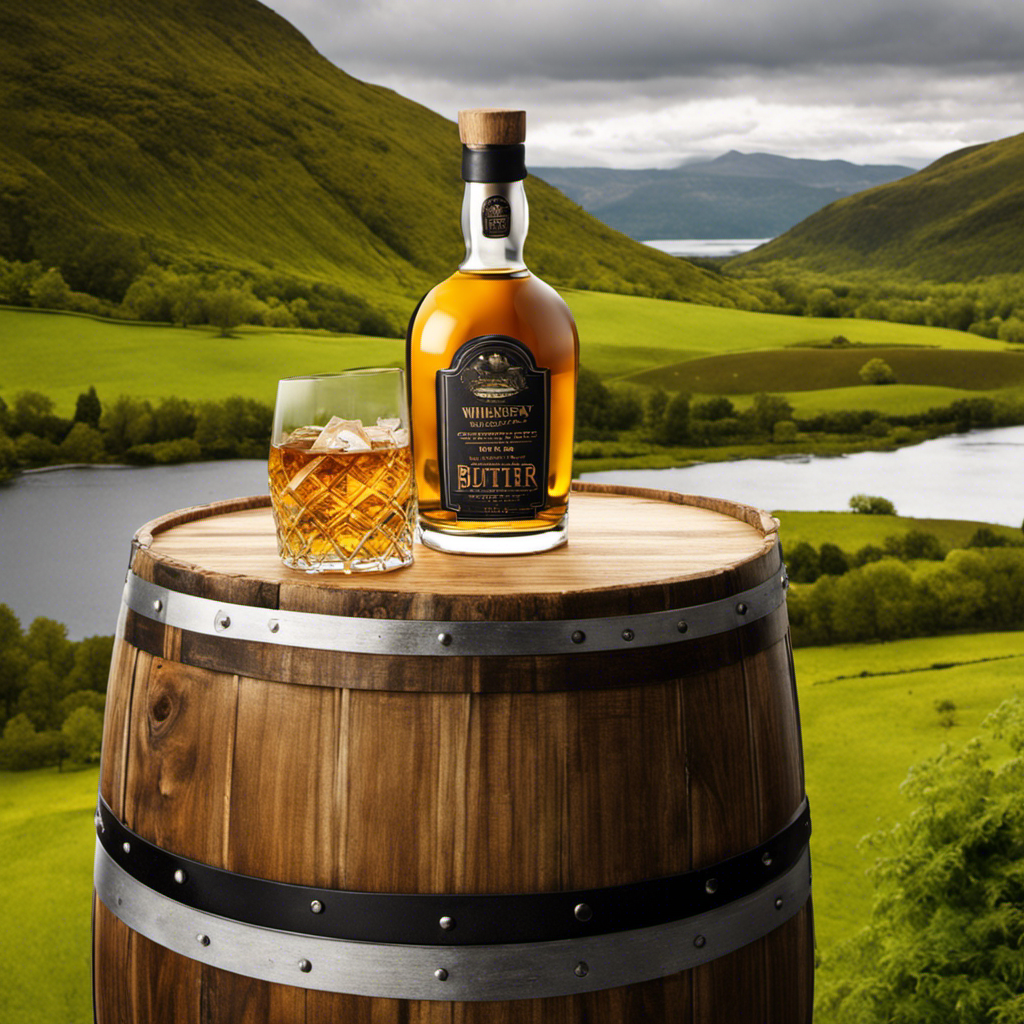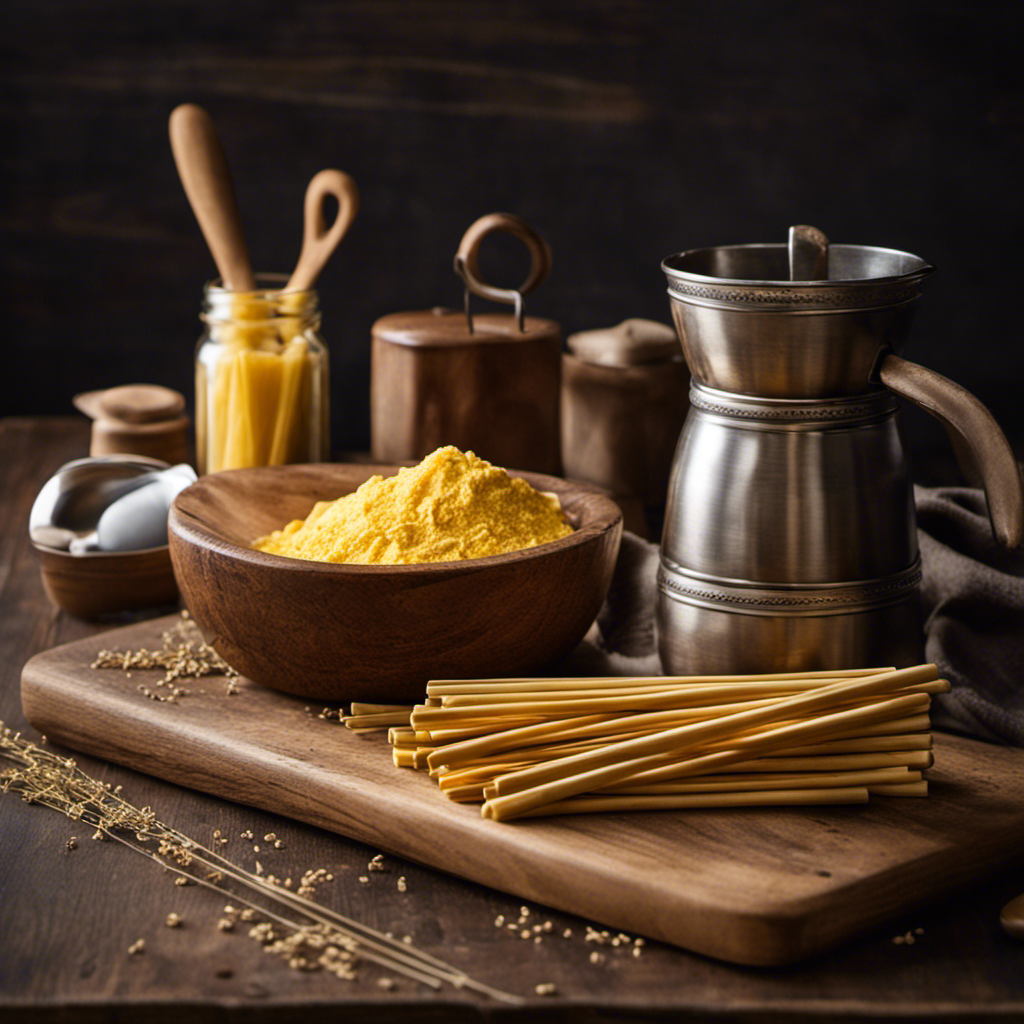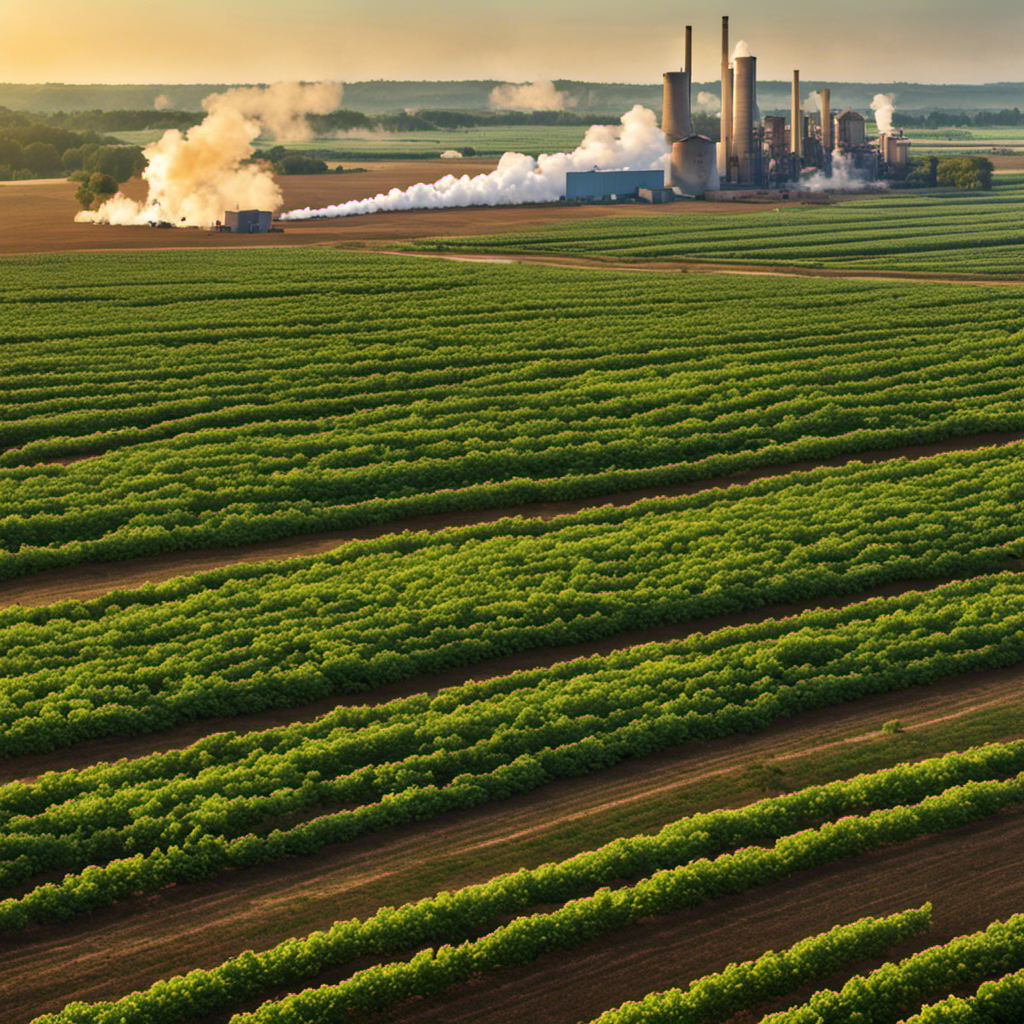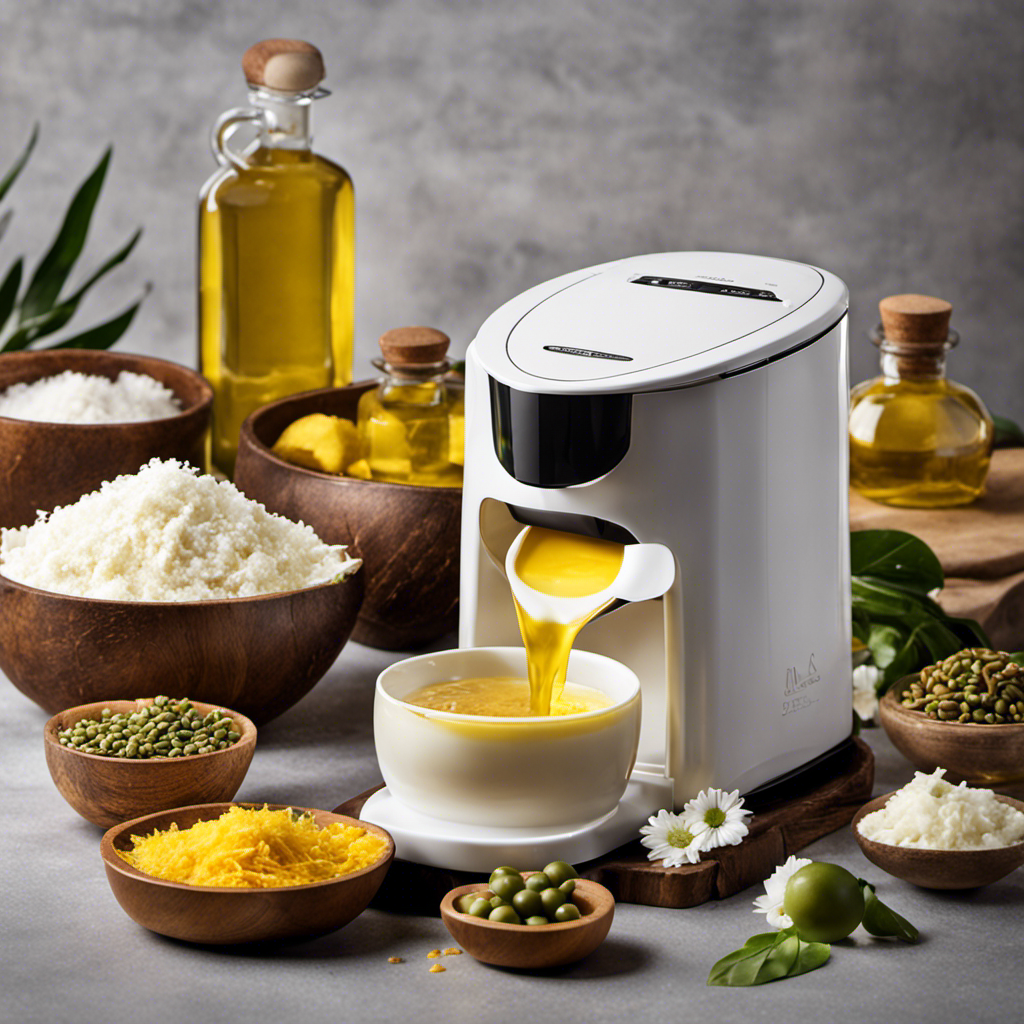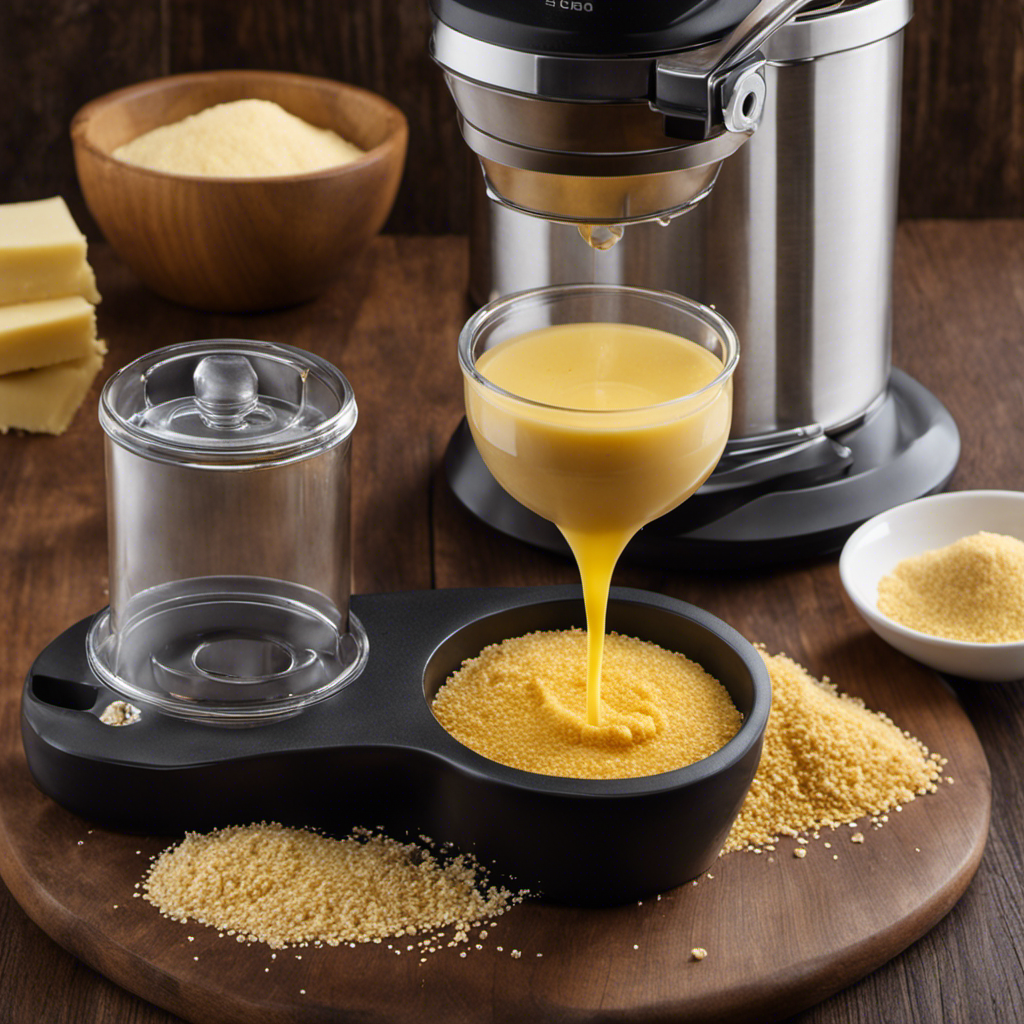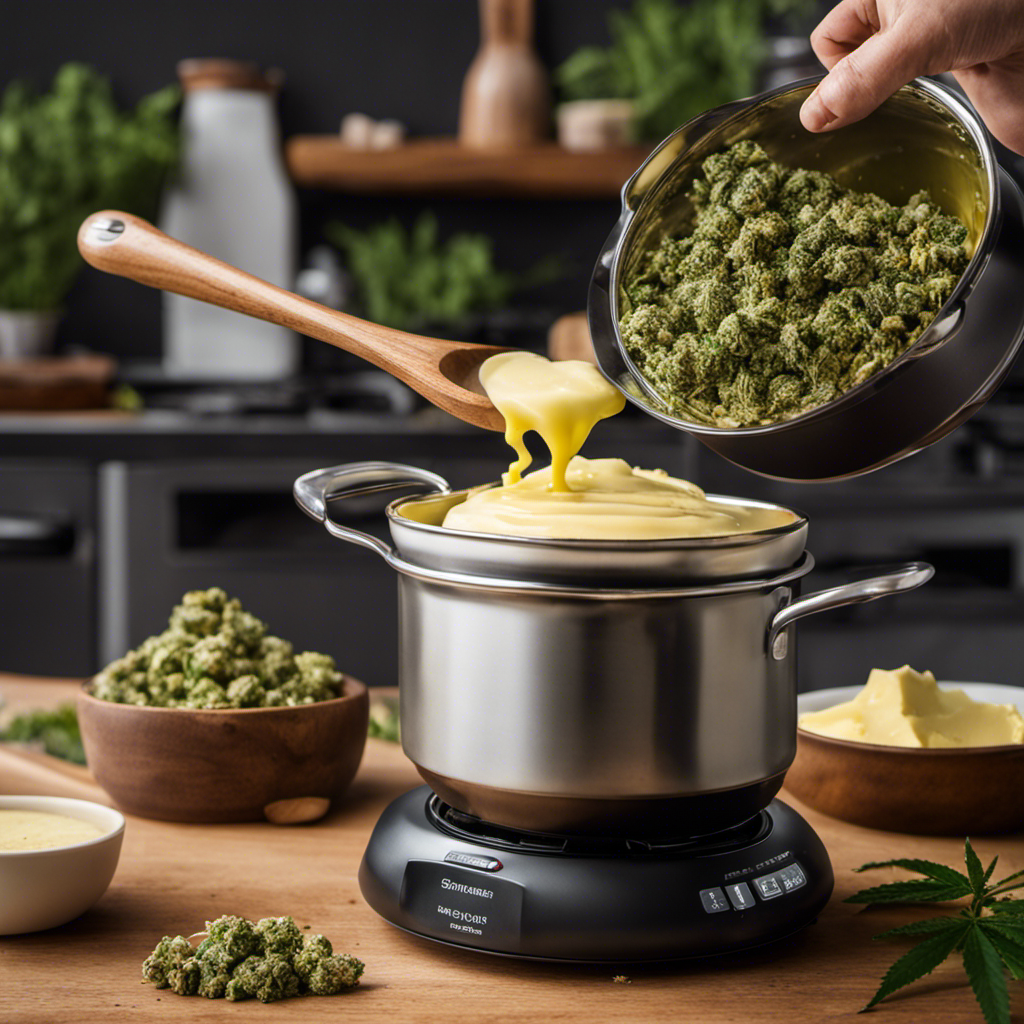As a whiskey lover, I have always been captivated by the complex process of whiskey production. From its rich history and traditions to the innovative techniques used today, there is a wealth of knowledge to delve into.
But what about the role of butter and the influence of Scotch whiskey? In this article, we’ll delve into the reasons why butter is a crucial ingredient for whiskey makers and how Scotch whiskey has shaped the alcohol industry.
Join me on this journey as we uncover the secrets behind the perfect glass of whiskey.
Key Takeaways
- Butter is added to whiskey before aging to mellow out the harshness of wood and create a smoother drinking experience.
- Distillation is a crucial step in whiskey production, with distilleries experimenting with vacuum distillation to preserve delicate flavors.
- Scotch whiskey has had a significant impact on the global spirits industry, contributing to international trade and symbolizing heritage and refinement.
- The debate between traditional methods and modern techniques in whiskey production raises questions about the future of the industry, balancing tradition with innovation.
The History of Whiskey Making
The history of whiskey making is a fascinating journey through time. Whiskey, a beloved spirit, has evolved over the centuries to become the complex and diverse beverage we know today.
The origins of whiskey can be traced back to ancient civilizations, where the art of distillation was discovered. As time went on, techniques improved, and different styles of whiskey emerged, such as Scotch, Irish, and Bourbon.
However, one significant event that had a profound impact on the whiskey industry was the era of prohibition in the United States. During this time, the production, sale, and consumption of alcoholic beverages were banned, forcing many distilleries to close their doors.
The end of prohibition marked a turning point, leading to the resurgence of whiskey making and the birth of new distilleries, forever shaping the whiskey industry.
The Role of Butter in Whiskey Production
Butter plays a significant role in the production of whiskey. While it may seem unusual, butter production is an essential step in creating the rich and complex flavors that whiskey enthusiasts love.
During the aging process, whiskey is stored in oak barrels, which impart flavors and aromas into the spirit. However, the wood can sometimes be too overpowering, resulting in an unbalanced taste. This is where butter comes in.
Before aging, a small amount of butter is added to the whiskey, which helps to mellow out the harshness of the wood and create a smoother, more enjoyable drinking experience. The butter acts as a natural emulsifier, binding together the various flavors and allowing them to harmonize over time.
Exploring the Distillation Process
When you’re learning about the distillation process, it’s fascinating to see how the flavors and aromas are concentrated through the heating and cooling of the liquid. Distillation is a key step in whiskey production, where alcohol is separated from impurities and the desired flavors are intensified.
Exploring innovation in distillation techniques has led to the development of new methods that enhance the quality and complexity of whiskey. For example, some distilleries are experimenting with vacuum distillation, which allows for lower temperatures and can preserve delicate flavors that might be lost with traditional methods.
Additionally, the impact of climate on whiskey aging cannot be underestimated. The temperature, humidity, and air quality of the aging environment all contribute to the final taste and character of the whiskey, making each batch truly unique. Understanding and adapting to these environmental factors is crucial for producing exceptional whiskey.
The Influence of Scotch Whiskey on the Alcohol Industry
When it comes to the influence of Scotch whiskey on the alcohol industry, there are three key points to consider: its impact on global markets, its cultural significance, and its deep-rooted tradition.
In terms of global markets, Scotch whiskey has become a staple in the spirits industry, with its production and consumption spanning across continents.
Culturally, Scotch whiskey holds a special place in the hearts of many, symbolizing heritage, sophistication, and refinement.
Lastly, the tradition of Scotch whiskey production dates back centuries, with distilleries upholding time-honored practices to create this beloved spirit.
Impact on Global Markets
You should consider the impact of whiskey and scotch makers on global markets.
The global economy is greatly affected by the trade dynamics of these industries. Whiskey and scotch are not just alcoholic beverages; they are valuable commodities that contribute to international trade and economic growth.
The demand for these spirits has created a thriving market, leading to increased exports and imports, and stimulating economic activity worldwide. Whiskey and scotch makers play a crucial role in shaping trade dynamics, as they navigate international regulations, negotiate trade agreements, and establish distribution networks.
The global market for whiskey and scotch is highly competitive, with various countries vying for market share. As consumers’ tastes evolve, whiskey and scotch makers must adapt, innovate, and maintain their position in the global marketplace.
Understanding the impact of these industries on the global economy and trade dynamics is essential for any discerning observer.
Cultural Significance and Tradition
The cultural significance and tradition surrounding whiskey and scotch are deeply ingrained in many societies around the world.
Whiskey, in particular, holds a special place in the hearts of people, as it represents not just a drink, but also a symbol of cultural preservation and traditional techniques.
The art of whiskey-making has been passed down through generations, with distilleries carefully guarding their recipes and methods. These traditional techniques ensure that the flavors and aromas of whiskey are preserved, creating a unique experience for enthusiasts.
Cultural preservation is also evident in the rituals and customs associated with whiskey consumption, such as whisky tastings and whiskey festivals. These events celebrate the rich history and heritage of whiskey, bringing people together to appreciate and enjoy this beloved spirit.
Traditional Methods Vs. Modern Techniques
When it comes to the age-old debate of tradition versus innovation, the world of whiskey production is no exception.
On one hand, there are those who argue that sticking to time-honored methods is crucial for maintaining the essence and character of the drink. Craftsmanship and attention to detail are emphasized, with a focus on preserving heritage and the artistry involved.
On the other hand, there are proponents of modern techniques, who believe that efficiency and progress are key in order to meet the demands of a rapidly evolving industry.
Ultimately, the clash between age-old practices and innovative approaches raises important questions about the future of whiskey production and the balance between tradition and advancement.
Age-Old Vs. Innovation
Although innovation is important, there is something timeless and intriguing about age-old traditions. Age-old techniques have been passed down through generations, honed and perfected over time. These methods have stood the test of time and continue to produce exceptional results. The precision and attention to detail that come with age-old techniques cannot be replicated by innovative approaches alone.
Innovation has its merits, of course. It allows for new possibilities and advancements in various fields. It brings fresh ideas and perspectives, pushing boundaries and challenging the status quo. However, it is important to recognize that innovation should not completely overshadow age-old traditions. There is a certain charm and authenticity that comes with using techniques that have been proven effective for centuries.
Craftsmanship Vs. Efficiency
You can appreciate the artistry and attention to detail in traditional craftsmanship, even though efficiency may be prioritized in modern times. Craftsmanship, with its emphasis on handwork and traditional techniques, holds a certain allure that cannot be replicated by automation.
Here are three sub-lists that highlight the deeper meaning behind the craftsmanship vs. automation debate:
-
Craftsmanship:
-
Preserves cultural heritage and traditional knowledge.
-
Allows for customization and uniqueness in each piece.
-
Demonstrates the skill and expertise of the artisan.
-
Automation:
-
Increases production efficiency and reduces costs.
-
Ensures consistency and uniformity in the final product.
-
Incorporates modern technology to streamline processes.
While automation may offer benefits in terms of speed and mass production, traditional craftsmanship brings a level of artistry and authenticity that cannot be replicated. It is important to strike a balance between the two, preserving traditional techniques while embracing the advantages of modern technology.
Heritage Vs. Progress
In the world of whiskey making, there is an ongoing debate between heritage and progress. Traditional methods passed down through generations are pitted against modern techniques that promise efficiency and consistency. As a whiskey enthusiast, I find myself caught between the nostalgia of the past and the allure of innovation.
To better understand this clash, let’s take a look at a comparison between traditional methods and modern techniques in whiskey production:
| Traditional Methods | Modern Techniques |
|---|---|
| Hand-mashing of grains | Automated mashing process |
| Copper pot stills | Continuous column stills |
| Aging in oak barrels | Rapid aging through technology |
| Small batch production | Large-scale industrial production |
Both approaches have their merits. Traditional methods, rooted in heritage, often yield unique and complex flavors. On the other hand, modern techniques offer consistency and efficiency, allowing for greater production volumes.
Ultimately, the choice between heritage and progress depends on personal preferences and the desired outcome. Some whiskey enthusiasts may appreciate the craftsmanship and depth of flavor that comes from traditional methods, while others may prioritize efficiency and accessibility offered by modern techniques. Whichever path is chosen, both heritage and progress play a vital role in the ever-evolving world of whiskey making.
The Science Behind the Butter-Scotch Connection
The science behind the butter-scotch connection is fascinating. Through scientific analysis, researchers have discovered the intricate relationship between butter and scotch, shedding light on the flavors and textures that make this combination so enticing. Here are some key insights:
-
Chemical Reactions:
The fats in butter interact with the alcohol in scotch, creating a smooth and creamy mouthfeel.
The caramel notes in scotch complement the rich, buttery flavors, enhancing the overall taste experience. -
Flavor Perception:
Butter’s high fat content coats the taste buds, intensifying the perception of the scotch’s flavors.
The combination of butter and scotch creates a unique flavor profile that is both indulgent and complex. -
Aroma Enhancement:
Butter’s aroma compounds enhance the aromatic notes present in scotch, heightening the olfactory experience.
Understanding the science behind the butter-scotch connection allows us to appreciate the combination on a deeper level, unlocking the secrets behind its irresistible allure.
Understanding the Flavor Profile of Whiskey
Understanding the flavor profile of whiskey can be a complex endeavor, as it involves unraveling the intricate combination of ingredients that contribute to its unique taste experience. Flavor development in whiskey is a result of various factors, including the grains used, the fermentation process, the type of yeast, the distillation method, and the aging process.
Sensory analysis plays a crucial role in understanding the flavors present in whiskey. By carefully examining the aroma, taste, and mouthfeel, experts can identify the different flavor components, such as fruity, floral, spicy, or smoky notes. This analysis helps whiskey enthusiasts appreciate the subtle nuances and complexities in each bottle.
Whether it’s the smooth sweetness of bourbon or the peaty richness of Scotch, the flavor profile of whiskey is a testament to the craftsmanship and artistry of the distiller.
The Art of Barrel Aging
Barrel aging is a crucial step in the whiskey-making process. It greatly impacts the flavor profile of the final product. During the flavor transformation process, the whiskey undergoes chemical changes as it interacts with the wood of the barrel. This results in the development of unique flavors and aromas.
Time and maturation play a significant role in this process. The longer the whiskey is aged, the more pronounced and complex its flavors become.
Additionally, the selection of the barrel type and the quality of the wood have a direct impact on the final flavor. Different types of wood impart distinct characteristics to the whiskey.
Flavor Transformation Process
During fermentation, yeast converts sugars into alcohol, which then undergoes a distillation process to create whiskey. The flavor development in whiskey is a fascinating transformation process that involves a series of intricate reactions.
To truly understand the depth of flavors, sensory analysis plays a crucial role. Here are three key aspects to consider:
- Raw Materials: The choice of grains, such as barley or corn, affects the flavor profile of the whiskey.
- Distillation Technique: The shape and size of the stills, as well as the cut points during distillation, influence the final flavor.
- Maturation: The interaction between the whiskey and the oak barrels during aging contributes to the development of complex flavors.
By carefully examining these factors through sensory analysis, distillers can create a whiskey with a well-balanced and nuanced flavor profile.
Now, let’s explore the impact of time and maturation on whiskey.
Time and Maturation
In my previous subtopic, I discussed the fascinating process of flavor transformation in whiskey production. Now, let’s delve into the crucial role that time and maturation play in this process.
One of the key factors contributing to the rich flavors of whiskey is barrel aging. Whiskey is aged in wooden barrels, typically made from oak, which impart unique characteristics to the spirit. As whiskey matures, it undergoes chemical reactions with the wood, resulting in the development of complex flavors and aromas.
To showcase the impact of time and maturation on whiskey, let’s take a look at the table below:
| Age of Whiskey | Flavor Profile |
|---|---|
| Young (3-5 years) | Bold, fiery, with hints of grain and spice |
| Mature (8-12 years) | Smooth, mellow, with notes of caramel, vanilla, and oak |
| Extra Aged (15+ years) | Deep, rich, with layers of dried fruit, dark chocolate, and tobacco |
As you can see, the longer whiskey ages in the barrel, the more it transforms, acquiring a sophisticated and nuanced flavor profile. Barrel aging is an art that whiskey makers master to create exceptional spirits that delight the palate.
Barrel Selection Impact
The choice of which wooden barrels to use greatly affects the flavor profile of aged spirits like whiskey. Barrel aging techniques play a crucial role in flavor development, as different types of wood can impart distinct flavors and characteristics to the whiskey.
Here are three important factors to consider when selecting barrels for aging:
-
Wood Type: The type of wood used, such as oak, plays a significant role in flavor development. Oak barrels are commonly used due to their ability to enhance the whiskey’s aroma, color, and taste.
-
Barrel Size: The size of the barrel affects the interaction between the whiskey and the wood. Smaller barrels allow for more contact and faster aging, while larger barrels provide a more mellow flavor over a longer period.
-
Barrel History: The previous contents of the barrel can influence the flavor profile. For instance, barrels previously used for aging wine may add fruity or tannic notes to the whiskey.
The Significance of Quality Ingredients
Using high-quality ingredients is essential for producing a great-tasting whiskey. When it comes to whiskey making, two key factors that greatly influence the flavor profile are terroir and climate change.
Terroir refers to the unique characteristics of the land where the ingredients are grown, including the soil composition, altitude, and weather patterns. These factors play a significant role in the flavor development of grains such as barley and rye, which are the primary ingredients in whiskey production.
Additionally, climate change has a direct impact on the quality of ingredients. Rising temperatures and unpredictable weather patterns can affect crop yields and alter the flavor profiles of grains. As a whiskey maker, it is crucial to carefully select ingredients from regions with favorable terroir and adapt to the changing climate to ensure the production of exceptional whiskey.
Moving forward, these considerations will shape the future of whiskey making.
The Future of Whiskey Making
As we explore the future of whiskey making, it is important to consider the innovations and sustainability practices that will shape this industry. Whiskey makers are constantly striving to improve their craft and create new experiences for whiskey enthusiasts.
Here are some key aspects to look out for:
-
Advanced distillation techniques:
Utilizing cutting-edge technology to enhance flavor profiles and improve efficiency.
Exploring new methods of aging whiskey to achieve unique and complex flavors. -
Sustainable sourcing and production:
Embracing organic farming practices to ensure the quality and sustainability of ingredients.
Implementing renewable energy sources to reduce carbon footprint and minimize environmental impact. -
Whiskey aging experiments:
Conducting research on alternative aging methods, such as using different types of wood or experimenting with temperature and humidity controls.
Frequently Asked Questions
How Long Has Whiskey Making Been Around?
Whiskey making has a rich history that spans centuries. Its evolution can be traced back to ancient times, where it was first distilled by monks. The process has since evolved, resulting in the diverse range of whiskey varieties we enjoy today.
How Does the Addition of Butter Affect the Taste of Whiskey?
Adding butter to whiskey can have a significant impact on its flavor. The butter adds a creamy and smooth texture, enhancing the richness of the whiskey. Butter infused whiskey recipes are becoming popular for their unique taste.
What Are the Different Steps Involved in the Distillation Process?
When making whiskey, different types of stills are used in a meticulous process. The aging process plays a vital role in developing the rich flavors and smoothness that are characteristic of a fine whiskey.
How Has Scotch Whiskey Influenced the Alcohol Industry?
Scotch whiskey has had a significant influence on mixology and has gained global popularity. Its unique flavors and production methods have elevated the whiskey experience, making it a favorite choice for many enthusiasts around the world.
Are Traditional Methods of Whiskey Making Still Used in the Modern Era?
Yes, modern distilleries use new techniques, but traditional whiskey making is far from a dying art. It’s like a well-aged oak barrel, rooted in history but still evolving, producing the smooth elixir we know as whiskey.
Conclusion
In conclusion, as a whiskey maker, I am constantly amazed by the intricate process of creating this beloved spirit. From the historical importance of butter in whiskey production to the influential role of Scotch whiskey, every step is a delicate dance of tradition and innovation.
Barrel aging adds depth and character, while quality ingredients elevate the final product. As I envision the future of whiskey making, I am filled with excitement and curiosity, eager to explore new techniques and flavors.
The journey of whiskey making is a fascinating blend of artistry and science, and I am honored to be a part of it.
